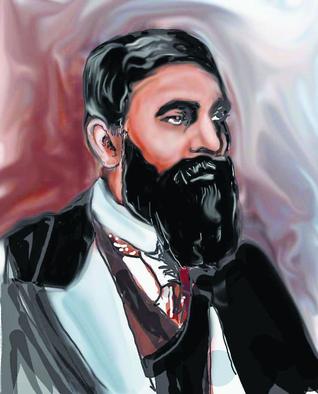
From curing ailments common and uncommon to initiating Durga Puja in Delhi, Dr. Hem Chandra Sen left behind an unforgettable legacy
Doc Holliday may have been a favourite with youngsters watching Western cowboy films over five decades ago, but long before that Delhi had its own bearded Doc whom few remember now. There were no motorised vehicles in 1879 when Dr. Hem Chandra Sen came here in a bullock cart all the way from Agra. Rich people travelled in palanquins, buggies or four-wheeled landaus and the poor in ekkas and carts. Women hardly showed their faces in public, they either wore burqas or ghoonghats and there was no electricity and piped water supply. In this milieu Dr. Sen became the first Indian allopathic doctor of Delhi.
From dispensing medicines to those building the E.I. Railways’ Agra-Delhi line, he started treating the local populace; women did not mind uncovering their heads and faces before him. Dr Sen was credited with “miraculous healing powers”, his day beginning at 4 a.m. and ending late at night. Rich and poor alike were treated by him. Those who couldn’t come to his chambers were visited by him, for which he used two sets of horse carriages — one for the morning and the other for the evening. He charged Rs. 2 (for the full treatment) from those whom he visited at home and nothing from patients who came to his clinic. He set up a pharmacy also, as getting medicines from Calcutta took a lot of time. Later it became a separate unit known as H.C. Sen and Company.
In 1883 Dr. Sen, founder of the Imperial Medical Hall, set up the Imperial Medical Press and type-setting moulding unit adjacent to his clinic. It was afterwards run by his nephew A.T. Roy, and the latter’s sons and grandsons, as one of the leading presses of Delhi. Member of the first management committee of Hindu College, Dr. Sen played a leading role in youth education along with Lala Shri Krishna Dass Gurwala (one of the founders of the college), M. M. Malaviya and many others of note.
Lala Krishan Dass Gurwala was among the seths who persuaded Dr. Sen to settle down in Delhi. It is interesting to note that the name Gurwala was appended to the family as it used to provide gur and gram to pilgrims, says the centenary brochure on Dr. Sen brought out in 1980. Gurwala’s grandfather was hanged by the British for supporting Bahadur Shah Zafar. The family traces its history to 1560 and Lala Nodhamal of Akbar’s reign. After Gurwala helped establish the Delhi Cloth and General Mills, it meant an extended practice for Dr. Sen. However when the good doctor fell seriously ill due to his exertions (“grace under pressure”, to quote Hemingway), the British Chief Commissioner of Delhi ensured that there was complete silence in the Fountain area of Chandni Chowk so that he was not disturbed. It’s worth mentioning that when Unani medicines were ineffective even the famous Ballimaran hakims did not hesitate in referring patients to Dr. Sen for a speedier cure.
Europeans also came to Dr. Sen, a Freemason, for treatment and for advice even on personal matters. Born in Calcutta before the 1857 Revolt, he died in 1906 and the Delhi markets were closed for a week as a mark of respect. He was succeeded by his sons, Dr B. C. Sen and Dr R.B. Sen (Adu Babu). From 1880 till his death Dr. Sen had stayed on in Delhi and among his guests were Rabindranath Tagore, Swami Vivekananda, novelist Sarat Chandra, Sir Surendranath Banerjee, Subhas Chandra Bose, Madan Mohan Malaviya, Hakim Ajmal Khan and the Maharajas of Jaipur and Jodhpur.
Interestingly, Vivekananda used to walk to the Yamuna every day through Chandni Chowk so long as he stayed in Delhi. The road from the Fountain leading to Old Delhi station is named after Dr. Sen and on Ansari Road in Daryaganj his descendants continue to maintain their 100-year-old pharmacy. Now a book on the legendary doctor, an initiator of Durga Puja in Delhi, is being written (at the behest of Anees Enterprises) by Shipra Sen to commemorate her ancestor whose medicines for curing diseases like jaundice, other liver infections and malaria are still popular. May be Doc Holliday too would have got rid of his bottle-induced problems had he cared to saunter (shoulder-strapped gun and all) into Dr. Sen’s celebrated 19th Century “Maktab” at the Fuwarra!
source: http://www.thehindu.com / The Hindu / Home> Features> FridayReview> History & Culture / by R. V. Smith / August 31st, 2014